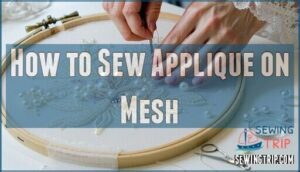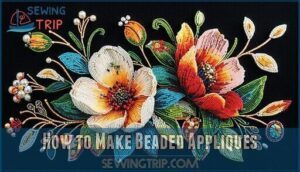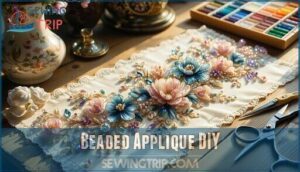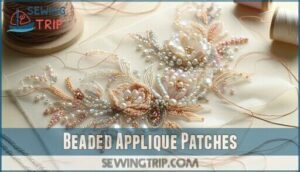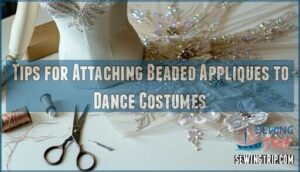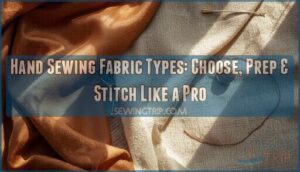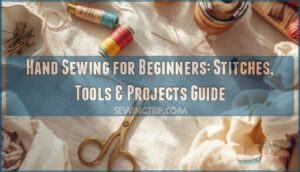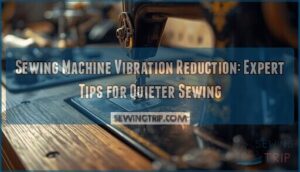This site is supported by our readers. We may earn a commission, at no cost to you, if you purchase through links.
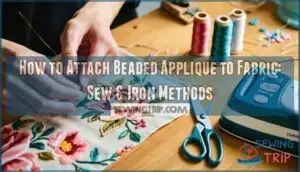
For sewing, position the applique and secure with pins, then use small, hidden stitches around the edges and through existing thread loops. Choose thread that matches your fabric’s color.
For iron-on varieties, place the applique adhesive-side down, cover with a pressing cloth, and apply heat according to manufacturer instructions. Always test on fabric scraps first—different fabrics respond differently to heat and adhesives.
The sewing method offers more durability, while iron-on provides quick application. Beyond these basics, specific techniques can transform your project from amateur to professional-looking.
Table Of Contents
- Key Takeaways
- Ways to Attach Beaded Applique to Fabric
- How to Sew on a Beaded Applique
- How to Sew Applique on Mesh
- How to Iron on Beaded Applique
- How to Make Beaded Appliques
- Beaded Applique DIY
- Beaded Applique Fabric
- Beaded Applique Patches
- Where to Buy Beaded Appliques
- Tips for Attaching Beaded Appliques to Dance Costumes
- Frequently Asked Questions (FAQs)
- Conclusion
Key Takeaways
- Choose sewing over iron-on for durability – You’ll get longer-lasting results with hand-sewing using invisible thread and small anchor stitches, especially for garments that’ll be washed frequently
- Test your method on fabric scraps first – You can avoid costly mistakes by practicing your attachment technique on leftover material before working on your main project
- Use proper stabilization for challenging fabrics – You’ll need wash-away stabilizer under mesh or stretch fabrics to prevent puckering and maintain structure during attachment
- Match your thread to fabric or beads – You’ll achieve professional-looking results by selecting thread colors that blend seamlessly with either your base fabric or the appliqué beads
Ways to Attach Beaded Applique to Fabric
When attaching beaded applique to fabric, you’ll choose between sewing vs. glue methods, each offering distinct advantages.
Sewing provides the most secure, long-lasting attachment that withstands washing and wear.
A stitch in time saves nine – secure attachment prevents applique disasters during wear.
Hand sewing with beading needles and polyester thread creates professional results, while temporary adhesives help position appliques before permanent attachment.
For applique stabilization, use soluble stabilizer as your foundation.
This dissolves away after completion, leaving clean edges.
Thread types matter—invisible thread creates seamless attachment, while matching colored thread blends naturally with your design.
Start by smoothing wrinkles from your garment, then position the beaded applique using pins or temporary adhesive.
When hand sewing, use small, consistent stitches along the perimeter, catching individual beads for security.
For fabric glue methods, apply thin layers to solid sections and edges, avoiding excess that creates stiffness.
For extra reinforcement, you can sew the edges of the applique after gluing.
The key to successful attachment lies in proper preparation and choosing the right combination of techniques for your specific project needs.
How to Sew on a Beaded Applique
Sewing on a beaded applique requires precision and the right technique. With invisible thread and proper anchor stitches, you’ll create professional-looking results that last.
- Begin with backside anchoring – Start from the fabric’s wrong side, securing your invisible thread with several tiny knots
- Perfect your stitch placement – Take small stitches along the applique’s edge, catching only the perimeter without going through beads
- Master secure knotting – Tie knots every few stitches to maintain thread tension and prevent unraveling
- Check your progress – Regularly examine the front to confirm your stitching line remains hidden
- Finish with anchor stitches – Complete your beaded patch attachment with multiple tiny backside knots
Hand sewing a beaded applique transforms ordinary fabric into stunning artwork. Move slowly and maintain consistent tension to avoid puckering while you attach applique securely to your project.
Consider using a blanket stitch approach for a decorative finish.
How to Sew Applique on Mesh
Working with mesh requires finesse since the fabric’s open weave can easily distort. You’ll need mesh stabilization to prevent puckering and careful needle choice for clean stitches.
Start by securing your beaded applique with glass-head pins, then hand-stitch around the perimeter using matching thread. A rhinestone applique can add a wow factor.
- Mesh stabilization: Use wash-away stabilizer underneath stretch mesh to maintain structure during stitching
- Needle choice: Select beading needles sized 10-12 for precise work through small bead holes and mesh layers
- Stitch tension: Keep stitches loose enough to preserve mesh flexibility while securing the beaded patch firmly
Small backstitch or whipstitch methods work best for attaching applique to mesh without visible lines. Your securing knots should anchor within the applique body, and beading patterns will shine through the mesh beautifully when properly attached.
How to Iron on Beaded Applique
Iron-on beaded appliques offer a quicker alternative to hand-sewing, but success depends on using the right materials and technique. Start by selecting appliques with heat-safe beads, as plastic beads can melt under high temperatures. Glass beads work best for this method.
Heat-safe beads make all the difference when ironing on appliques successfully.
Preparation is key to achieving professional results:
- Use a protective cloth over the applique to shield beads from direct heat
- Set your iron to medium heat (250-300°F) without steam for proper glue adhesion
- Apply firm, steady pressure for 10-15 seconds without moving the iron
- Test on fabric scraps first to confirm your iron temperature won’t damage materials
- Plan placement carefully since repositioning issues make corrections difficult
Position your applique precisely before ironing, as the strong bond makes adjustments nearly impossible. For best results, consider using a clean, fluffy towel underneath your fabric. Press firmly and hold steady—no back-and-forth motions that could shift beads. Allow the piece to cool completely before handling to guarantee the adhesive sets properly.
How to Make Beaded Appliques
Creating your own beaded applique transforms fabric into wearable art. This craft combines Design Inspiration with personal creativity to produce stunning embellishments for clothing and accessories.
Material Selection forms the foundation of successful beadwork. Choose stable base fabrics like felt or mesh that won’t fray when cut. Your Color Palettes should complement the final garment while providing enough contrast for the beads to pop.
Here’s your applique tutorial process:
- Sketch your design lightly in pencil on the base fabric, marking key placement points for larger elements
- Frame the outline using Beading Techniques like backstitch with fishing line or invisible thread for clean edges
- Fill the interior by sewing individual beads with matching thread, working from center outward to prevent puckering
- Cut carefully along beaded edges once complete, avoiding damage to your stitching
Applique Shapes can range from simple geometric patterns to complex floral motifs. Start with basic designs to master fundamental beadwork skills before attempting intricate pieces. Your custom creations will elevate any garment with unique, handcrafted elegance. Understanding applique techniques is essential for achieving professional-looking results in your beaded applique projects.
Beaded Applique DIY
Jump into DIY beaded applique projects by sketching your unique designs on felt or ultrasuede for stability.
Proper fabric prep makes for smooth stitching, while selecting quality beads and applique tools makes the process enjoyable.
Start with simple beadwork design patterns, then advance to complex beaded embroidery techniques.
Frame your design with a beaded edge using invisible thread, then fill interior spaces with individual beads.
DIY applique creation lets you customize colors and patterns perfectly.
These handmade beaded applique pieces add personal flair to any garment or accessory project.
Mastering various applique techniques can enhance your overall beaded applique design skills.
Beaded Applique Fabric
Your fabric selection sets the stage for stunning beaded applique results. When choosing your base material, consider how different textures showcase beadwork.
Beaded tulle, weighing 30-200 g/m², creates ethereal overlays perfect for evening wear, while heavier beaded lace at 82-484 g/m² provides structure for formal gowns.
For fabric prep, make certain your material can support the weight of your chosen beads. Mesh and net bases offer flexibility for body-forming silhouettes, while opaque options like beaded jacquard and tweed handle heavier embellishments without sagging.
Velvet and Ultrasuede work exceptionally well since they don’t fray and provide stable surfaces for intricate beadwork design. Thread types matter too – polyester or nylon offers superior strength for securing beads compared to cotton.
Match your thread color to either the fabric or beads for seamless integration. For applique care, verify colorfastness between fabrics and beads to prevent dye transfer.
Consider your project’s final use when selecting materials. Dance costumes need lightweight, flexible fabrics, while structured garments can accommodate heavier beaded options up to 1,173 g/m². Understanding fabric types is vital for achieving the desired aesthetic and durability in your beaded applique projects.
Beaded Applique Patches
Beaded applique patches offer endless possibilities for transforming ordinary garments into stunning fabric embellishments.
These pre-made decorative elements eliminate the time-consuming process of individual bead placement while delivering professional-looking results.
Whether you’re working with mesh-backed patches for bridal wear or felt-based designs for casual clothing, proper patch design consideration guarantees your beadwork complements the garment’s overall aesthetic.
When selecting beaded patches, consider these key factors for superior results:
- Fabric Selection: Choose patches with bases that match your garment’s weight and drape requirements
- Bead Placement: Ensure the patch’s beading pattern aligns with your garment’s design lines and seams
- Applique Care: Select patches that can withstand your garment’s washing and maintenance requirements
- Patch Design: Match the patch’s style and color scheme to your overall fashion vision
Modern beaded patches come in countless designs, from geometric patterns using size 11 and 15 seed beads to elaborate floral motifs featuring cabochons and metallic accents.
The key to successful sewing applique lies in thoughtful placement that enhances rather than overwhelms your garment’s silhouette.
Understanding applique techniques is vital for achieving a professional finish and guaranteeing the longevity of your beaded applique patches.
Where to Buy Beaded Appliques
Shopping for beaded appliques opens up a world of creative possibilities for your next project.
You’ll find the best selection through these reliable sources:
- Online Stores – Etsy offers thousands of custom and vintage options, while Mood Fabrics ships over 400 styles within one business day
- Craft Shops – Michael’s, Joann, and Hobby Lobby stock basic felt shapes and starter appliques for beginners
- Wholesale Suppliers – Faire and Global Sources connect you to bulk suppliers offering significant discounts on large orders
- Specialty Boutiques – Bridal Fabrics and Crystal Couture provide premium rhinestone and crystal options with worldwide shipping
- Bead Markets – Local fabric districts and vintage shops offer unique finds you won’t discover elsewhere
Most retailers offer sample ordering, so you can test quality before committing to larger purchases.
When selecting fabrics, understanding fabric types is essential for a successful applique project.
Tips for Attaching Beaded Appliques to Dance Costumes
When attaching beaded appliques to dance costumes, proper technique guarantees your costume embellishments survive every spin and leap.
Choose attachment methods that balance security with garment flexibility.
- Use whip stitch with double-threaded needles – This sewing technique provides maximum bead security during high-energy performances
- Pre-stretch fabric on a dress form – Maintains dance wear flexibility after applying beadwork techniques to stretch materials
- Combine hand sewing with fabric glue – Dual attachment methods offer extra hold for costume embellishments on mesh or velvet
- Space stitches 1cm apart along edges – Prevents rhinestone chains from catching and unraveling during movement
- Test fabric choice compatibility – Confirm beaded applique materials won’t damage delicate costume fabrics during garment embellishment
To achieve professional results, understanding applique techniques is essential for any fabric artist working with beaded appliques.
Frequently Asked Questions (FAQs)
How to attach bead applique to fabric?
Perfect timing—you’ve stumbled upon the craft world’s best-kept secret.
First, position your appliqué carefully, then secure it with invisible thread using small anchor stitches every half-inch around the edges for professional results.
This ensures that your work looks polished and well-executed, making the most of the appliqué technique.
How long does it take to glue a beaded applique?
Fabric glue typically takes 10-15 minutes to become tacky, then you’ll press the applique down and let it set for 24 hours to fully cure and bond permanently.
How do you apply iron beaded applique?
Iron-on is absolutely revolutionary for quick applique attachment.
Position your beaded applique, cover with protective cloth, then press with high heat and no steam for 60 seconds.
Keep iron stationary to prevent shifting.
How do you applique a fabric?
Position your applique on smooth, wrinkle-free fabric using pins for temporary placement.
Sew around edges with small, invisible stitches, catching the applique edge without going through to the front.
Work slowly and knot frequently for security.
Can you sew applique by hand?
Coincidentally, many crafters wonder if machines are essential for applique work, but you’ll find hand-sewing beaded appliques creates stunning results.
Use small, secure stitches with invisible thread, anchoring frequently to prevent shifting during wear.
How do you attach a bead to a fabric?
Thread your needle with matching thread and tie a secure knot.
Push the needle up through the fabric from underneath, slide the bead onto the needle, then push back down through the fabric close to where you started.
Will fabric glue hold beads to fabric?
Fabric glue can temporarily hold beads to fabric, but it’s not the strongest option. You’ll want to use textile-specific adhesive and reinforce with stitching for durability and washing.
How do you clean beaded appliques after attachment?
Like tending a delicate garden, you’ll hand-wash beaded appliques in cool water with mild detergent, gently pressing out moisture, then air-dry flat to preserve their sparkle.
Can beaded appliques be removed and reused?
You can remove and reuse beaded appliques if they’re sewn on, but it’s tricky. Carefully cut threads without damaging beads or fabric. Iron-on appliques can’t be reused once heated.
What thread weight works best for beaded appliques?
Like choosing the perfect fishing line for delicate catches, you’ll want 50-weight polyester or nylon thread for most beaded appliques.
This weight provides strength without bulk, easily passes through small bead holes, and won’t overpower your fabric’s texture.
Conclusion
Like a skilled seamstress threading her needle with confidence, mastering how to attach beaded applique to fabric transforms your creative projects from ordinary to extraordinary.
Whether you’ve chosen the reliable sewing method for long-lasting durability or the convenient iron-on approach for quick fixes, you’re now equipped with professional techniques.
Remember to test your chosen method on fabric scraps first, select appropriate thread colors, and work with steady hands.
With practice, you’ll confidently tackle everything from delicate evening gowns to vibrant dance costumes, creating stunning pieces that showcase your newfound expertise.

